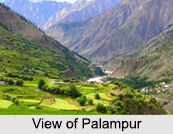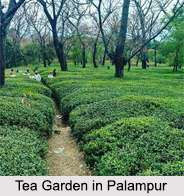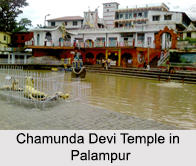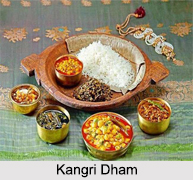 Palampur is the hill station and municipal council in the Kangra Valley of Himachal Pradesh. It forms one of the prominent spots in the beautiful valley encircled by pine trees and tea gardens. Bordered by Dhauladhar Ranges, Palampur is the tea capital of northwest India.
Palampur is the hill station and municipal council in the Kangra Valley of Himachal Pradesh. It forms one of the prominent spots in the beautiful valley encircled by pine trees and tea gardens. Bordered by Dhauladhar Ranges, Palampur is the tea capital of northwest India.
Etymology of Palampur
Palampur derives its name from the local term "palum", which means lot of water. Different streams are flowing down the plains of Palampur from the mountains; so the greenery and the water of Palampur make the place astonishingly beautiful.
History of Palampur
Palampur, an important city in Kangra Valley, was once a part of the Jalandhar kingdom. The town came into everyone"s focus when Dr. Jameson, Superintendent of Botanical Gardens, introduced the tea bush from Almora in 1849. The bush prospered and so did Palampur, which then became the focus of the European tea estate owners with an exception of the famous Wah Tea Estate. It was owned by Nawab Muhammad Hayat Khan and his descendants, until 1947. Since then, the Kangra tea of Palampur has got popular internationally.
In 1941, Pandit Jawahar Lal Nehru came to visit Palampur during British reign; to commemorate that event; there is a place in Palampur named Nehru Chowk.
 Geography of Palampur
Geography of Palampur
Palampur located at 32.12 degree north, 76.53 degree east, is situated at a height of 1470 meters above sea level. The main attractive spot of this place is situated at a height of 1219 meters, which is encompassed by pine trees and tea gardens. Dhauladhar ranges are located behind the town, whose tops stay covered with snow for most of the time in a year. Currently this place is getting developed as a tourist spot. Several trekking routes lead out of Palampur, particularly over the Dhauladhar ranges towards the districts of Chamba and Kullu in Himachal Pradesh.
Climate in Palampur
Palampur experiences a very favorable climate. Summer season from the month of April to June provides a pleasant and warm climate having temperature ranging from 15 degree C to 29 degree C. The winter season in the valley starts from the month of November till February which is very cold, having a minimum temperature of -4 degree C. During this period snowfalls are very common whereas the monsoons bring in very little rainfall.
Demography of Palampur
Total population of Palampur is around 70,000. Female sex ratio is 953 against the state average of 972. Child ration is 854 against state average of 909. Literacy rate is 91.33%. Male literacy is 92.96% and female literacy rate is 89.64%.
 Festival in Palampur
Festival in Palampur
Palampur is sprinkled with a myriad of colours during the festival of Holi which occurs on a full moon day in the month of Falgun, one of the months of Hindu calendar. The village women offer special Puja at the time of Holi. Little twigs of the `Kamal` tree are decorated in red and yellow colours and then set out in little bamboo baskets or khartoo with thread, jaggery, kumkum and roasted grams. This basket and small pots of coloured water are carried by the women in their hands for the Puja and they offer it first to the elderly man or Dandochh and then the festival of Holi is observed.
The entire village plays Holi the next day. The Holi bonfire is lit once the moon comes out in the night before Holi. Young men compete among themselves to first touch the Holi flag, because there is a belief that whoever touches it first becomes lucky. Special Kadah Prasad or sweet gruel is prepared and distributed among all. The major attraction of the Holi festival in Palampur is the cultural nights. The cultural nights are arranged by the Holi Kala Manch with contribution from the municipal committee and the local MLA. Other festivals of this place are Sair, which is celebrated in chaitra mass (from mid of March to mid of April) and Lohri, which is celebrated in mid January. Kangri Dham is a food festival of Himachal Pradesh.
Education in Palampur
Some of the major educational institutions in Palampur include the Saheed Captain Vikram Batra Degree College. It is located in close proximity to the main city of Palampur. The institution is named after Param Veer Chakra Vijeta, Saheed Captain Vikram Batra, who sacrificed his life in Kargil War in the year 1999 for India. St. Pauls` School is among the oldest schools in Palampur, constructed at the time of British rule in the year 1923. Chaudhary Sarwan Kumar Himachal Pradesh Krishi Vishwavidyalaya is among the four universities of Himachal Pradesh located in Palampur. It is also known as CSK HPKV or Himachal Pradesh Agricultural University. The University was founded in the year 1978. Another notable institution is the COVAS or College Of Veterinary and Animal Sciences. Founded in the year 1986, COVAS is located at Holta, a small place in the valley of Palampur. The Kendriya Vidyalaya in Palampur is located in Holta Camp. It is affiliated to the central board of secondary education, New Delhi.
 Tourism in Palampur
Tourism in Palampur
Palampur has numerous Buddhist monasteries and this place is famous for its Tibetan people as they have helped in making Palampur extra beautiful. Main attractions of Palampur are Devi Latti Jakhni"s Temple, Birni Mata Temple, Chamunda Devi Temple, Tashi Jong Buddhist Monastery, Shiva Temple, The Solitude Camp, Old Vindhyavasini Temple, Mata Bandla Devi Temple, Bamboo Museum, Sobha Singh Art Gallery, Mata Ashapuri mandir, Neugal Khad, Bundla Stream, Bundla Tea Estate, Andretta, Saurabh Van Vihar and Gopalpur Zoo.
There are numerous shopping complexes in Palampur which also include showrooms of renowned international brands. Apart from that, old co-operatives like Bhuttico, which are popular for their high quality woolen garments, have also set up shops there. Some good restaurants, dhabas and fast food chains are also there in the town; some of which even offer authentic local food including Kangri Dham (traditional food of Himachal Pradesh, mainly cooked during the food festival with the same name).
Visiting Information to Palampur
The best time to visit Palampur is anytime except the extreme winter months of December and January. Palampur is connected by narrow gauge Kangra Valley Railway from Pathankot and the name of the railway station is Palampur. Nearest airport is Kangra Airport, Gaggal. The town is well connected to all major cities by bus routes; Himachal Road Transport Corporation provides regular buses for travelling. Pathankot-Mandi National Highway is a major highway that passes through Palampur town.



















